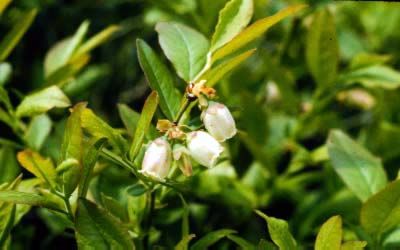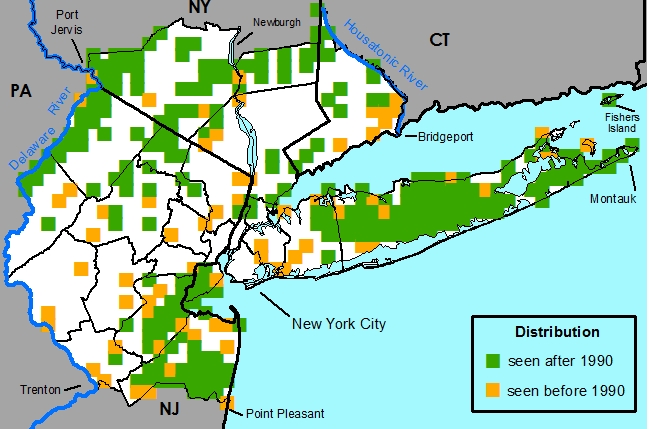Vaccinium angustifolium Ait. - Lowbush Blueberry

Lowbush Blueberry
Photo © Steven Clemants, 1990, taken at West Point, NY.
Common Names
Lowbush BlueberryField Identification
A shrub up to 2 ft tall with narrow, serrate leaves and urceolate white flowers.Food uses
Disclaimer: The information provided here is for reference and historical use. We do not recommend nor do we condone the use of this species for food purposes without first consulting a physician.(Hedrick, 1972) (Hussey, 1974) (Onstad, 1996)
The berries are eaten raw, smokedried, boiled, baked, and in a water gruel. Dried in the sun (it is immune to decay) and used instead of currents. The berries are highly perishable and last only about 7 days. Blueberries have one of the highest concentrations of iron of the temperate fruits.
Medicinal uses
Disclaimer: The information provided here is for reference and historical use. We do not recommend nor do we condone the use of this species for medicinal purposes without first consulting a physician.Blueberries are well known as a laxative. In addition, they are blood cleansers, improve circulation and benefit eyesight. They may also protect against cataracts and glaucoma. Other research suggests they may be useful in the treatment of varicose veins, hemorrhoids, and peptic ulcers. Furthermore, they are purported to be good for allaying the heat of fevers and hot agues.
Other uses
(Sheppard, 1991)An important species for the assessment of pollutant impacts in boreal areas.
Common names
Britton's Blueberry
Huckleberry
Lamark's Sugar Blueberry
Low Sugar Blueberry
Lowbush Blueberry
Sugarberry
Upland Blueberry
Nomenclature
*Vaccinium pensylvanicum Lam., Encycl. 1: 74. 1783, nom. illeg. (Art. 53.1). *Vaccinium angustifolium var. laevifolia House, New York State Mus. Bull. 243-244: 61. 1923. *Vaccinium lamarckii Camp, Bull. Torrey Bot. Club 71: 180. 1943. TYPE: growing in the Jardin du Roi (Paris) (Holotype: P).*Vaccinium angustifolium Aiton, Hort. Kew 2: 11. 1789. *Cyanococcus angustifolium (Aiton) Rydb., Brittonia 1: 94. 1931. *Vaccinium pensylvanica var. angustifolia (Aiton) A. Gray. Manual, 261. 1848. TYPE: Location unknown. Anonymous s.n. (Lectotype: BM), selected by (Vander Kloet, 1989). Location is Pouch Cove, Nfld. in (Vander Kloet, 1972).
*Vaccinium pensylvanicum var. nigrum A. W. Wood, Class-Book Bot. ed. s.n. (b), 483. 1861. *Vaccinium nigrum (A. W. Wood) Britton ex Britton et al., Mem. Torrey Bot. Club 5: 252. 1894, nom. illeg. (Art. 53.1). *Vaccinium angustifolium var. nigrum (A. W. Wood) Dole, Fl. Vt., 3rd. ed., 210. 1937. *Vaccinium angustifolium f. nigrum (A. W. Wood) B. Boivin, Nat. Canad. 93: 437. 1966. TYPE: Type not cited.
*Vaccinium pensylvanicum f. leucocarpum Deane, Rhodora 3: 264. 1901. *Vaccinium angustifolium var. laevifolium f. leucocarpum (Deane) Rehder, J. Arnold Arb. 20: 426. 1939. TYPE: United States. Maine: Mt. Desert Isl., Jordan Mtn., 2 Sep. 1892, E. L. Rand s.n. (Holotype: NEBC! #00055526).
*Vaccinium brittonii Porter ex Bicknell, Bull. Torrey Bot. Club 41: 420. 1914. TYPE: United States. Massachusetts: Nantucket Island; Tom Never's Swamp, 13 Jun 1908, E. P. Bicknell s.n. (Holotype: NY!).
*Vaccinium angustifolium var. hypolasium Fernald, Rhodora 51: 104. 1949. TYPE: Type not cited, avowed substitute for V. pensylvanicum var. myrtilloides sensu Fernald, Rhodora 10: 148. 1908.
Description
HABIT perennial, deciduous, chamaephyte, shrubs, autotrophic, monoclinous, with fibrous roots, 0.1-0.6 m tall, with rhizomes.STEMS prostrate or ascending or erect, round, not winged, "regular". Prickles absent. Bark striate, not exfoliating, gray or dark orange or dark yellowish orange. Branches ascending, reddish orange or dark orange or dark yellowish orange, round, not winged, 3-4 mm in diam. Twigs green or dark yellow or dark greenish yellow, not odoriferous, angular, 0.5-0.7 mm in diam., warty, glabrous or hairs long and unbranched, erect, unicellular, uniseriate, white, sparse to dense, throughout, glabrescent, without glands. Pith present, yellowish orange, round, continuous, nodal diaphragm absent. Thorns absent. Aerial roots absent. Sap translucent. Resin absent.
BUDS terminal and axillary buds monomorphic, Terminal bud absent. Axillary buds present, 1, ovoid, 0.7-1.4 mm long, pointed. Bud scales 6, dark red or dark orange-red, imbricate, ovate, chartaceous, cuspidate, glabrous, without glands. Leaf scars narrowly crescent shaped, 0.2-0.3 mm high, 0.8-0.9 mm wide, none. Vascular bundle scars 1, circular, 0.1 mm tall.
LEAVES alternate, 1 per node, spaced ± evenly along stem, divergent from stem, simple. Stipules absent. Leaves sessile. Leaf: abaxial surface green or greenish yellow, adaxial surface light greenish yellow or green, blades narrowly elliptic or elliptic, plane, symmetric, 1.5-4 cm long, 0.6-2 cm wide, chartaceous, base cuneate, margin serrate (gland-tipped), apex acute and mucronate, abaxial surface glabrous or hairs short and unbranched, erect, unicellular, uniseriate, white, sparse, along midveins, glabrescent, without glands, adaxial surface hairs short and unbranched, appressed, unicellular, uniseriate, white, sparse, along midveins, glabrescent, without glands. Brochidodromous venation, veins 4-6. Leaf lobes absent. Spines absent. Tendrils absent.
INFLORESCENCES monomorphic, regular or, if dimorphic, female inflorescence simple, corymbose raceme, axillary. Peduncle absent. Rachis present, 0.3-0.5 cm long, with bracts. Bracts sessile, blades: abaxial surface orange-red or reddish orange or orange, adaxial surface orange-red or reddish orange or orange, widely ovate or very widely ovate, involute, 1.2-2 mm long, 1.1-1.2 mm wide, base attenuate or truncate, margin entire, apex mucronate and acute or mucronate, abaxial surface glabrous, without glands, adaxial surface glabrous, without glands. Pedicel 1.7-4 mm long, glabrous, without glands. Bracteoles 2, sessile, at base of pedicel to at apex of pedicel, not connate, bracteoles: abaxial surface orange-red, bracteole: adaxial surface orange-red, oblanceolate, involute, 1.9-2.3 mm long, 0.2-0.9 mm wide, base attenuate, margin entire, apex obtuse. Cupules absent.
FLOWERS precocious, formed on short shoots, monomorphic, with sepals and petals readily distinguishable from one another, bisexual. Perfect or female flowers white, 5-merous, 4.8-7 mm long, 3.6-4.5 mm wide, 2-7 flowers per inflorescence, fragrance absent. Calyx present, actinomorphic, campanulate, of fused sepals, persistent, abaxial and adaxial surfaces the same color, green, 2-2.6 mm long, 3-4.5 mm wide, tube 0.9-1.7 mm long, calyx limb 1.2-1.4 mm long, 3.5-3.6 mm wide. Sepals or sepal lobes 5, ovate or widely ovate or very widely ovate or widely depressed ovate, 0.9-1.4 mm long, 1.1-1.7 mm wide, base truncate, margin entire or undulate, apex acute, abaxial surface glabrous, without glands, adaxial surface glabrous, without glands. Epicalyx absent. Corolla present, actinomorphic, tubular or urceolate, of fused petals, deciduous, abaxial and adaxial surfaces the same color, white, occasionally striped with pink, 4.2-5.1 mm long, 3.6-4.5 mm wide, corolla limb 0.7-0.9 mm long, 3.6-4.5 mm wide. Petals or petal lobes 5, depressed ovate or widely depressed ovate, 0.7-0.9 mm long, 0.9-1.8 mm wide, base truncate, margin ciliate (papilose), apex acute or obtuse, abaxial surface glabrous, without glands, adaxial surface papillose, unicellular, uniseriate, white, moderately dense, apically, not glabrescent, without glands. Gynoecium syncarpous. Carpels 5. Stigmas 1, truncate. Styles not persistent, 1, 4.3-5.9 mm long. Ovary inferior, 0.7-0.9 mm long, 1.3-2.1 mm wide, nectiferous disk present. Locules 5. Placentation apical axile. Androecium obdiplostemonous. Stamens 10, 3.2-4.2 mm long. Anthers narrowly ovoid, opening by pores in terminal tubes, opening 1/4 of entire anther, bithecal, yellowish orange or orange-yellow, glabrous. Filaments free, straight, light yellow, hairs short and unbranched, erect, unicellular, uniseriate. Staminodes absent.
FRUITS bacca (berry), blue or black (rarely white), globose, 6.3-9 mm long, 6.3-9 mm wide, glabrous, without glands.
SEEDS 8 to 16, orange-yellow, oblong, (0.6-)1.1-1.3 mm long, (0.5-)0.7-1.1 mm wide, wingless, not tailed, reticulate-foveate or reticulate.
Habitat
(Chapman & Crow, 1981) (Wherry, 1920) (Wherry, 1920)Dry areas (sandy and rocky woods, pine clearings, dry fields, dry scrub oak woods, pine barrens, beech-hemlock-oak woods, and mixed mesic woods). In dry and occasionally moist upland peat, with pH of 2.8-6.6.
Fire stimulates asexual reproduction and effects flower initiation. All plants are sterile the year following a burn but flower profusely during the second year.
Rarity Status
Heritage global rank -- ?Connecticut -- Not listed
New Jersey -- Not listed
New York -- Not listed
Species Biology
FloweringApril [week 3] - May [week 4] and September [week 4] - November [week 4].
Pollination
(Boulanger et al., 1967) (Finnamore & Neary, 1978) (Hall et al., 1979) (Lee, 1958) (Lomond & Larson, 1983) (Lovell & Lovell, 1937) (Pritts & Hancock, 1984) (Rajotte, 1979) (Stephen, 1954) (Vander Kloet, 1976) (Vander Kloet, 1978)Mellitochory -- Wild bees are the most common visitor and probable pollinator, but some authors say the flowers are not very attractive to bees. At least 192 species of insects are reported as casual visitors. Among the more common visitors are: Andrena carlini Ckll., A. carolina Vier., A. regularis Mall., A. vicina Sm., Apis mellifera L., Bombus perplexus Cr., B. sandersonii Fkln., B. ternarius Say, B. terricola Kby., Colletes inequalis Say, C. validus Cr., Lasioglossum quebecense (Cr.), L. viridatus (Ckll).
Autogamy -- Self-fertile but requires a pollinator; functionally and physiologically self-sterile.
Fruiting
June [week 2] - August [week 2] (November [week 1]).
Dispersal
(Crossland & Vander Kloet, 1996) (Eaton, 1957) (Quimby, 1951) (Vander Kloet, 1978) (Vander Kloet & AustinSmith, 1986) (Vander Kloet & Hill, 1994)Endozoochory -- Eaten by birds, particularly robins. Bears, skunks, ptarmigans also eat the berries, and they are an important food of jumping mice (Zapas hudsonius).
Germination
(Chapman & Crow, 1981) (Crossland & Vander Kloet, 1996) (Hall et al., 1979) (Vander Kloet, 1976)Reproduction through seedlings is rare. Germination requires a cool spring, wet August and September, mild winter and wet following spring. Germination is greater in light than dark. Seeds germinate readily at 21 degrees Centigrade; it usually takes about 21 days.